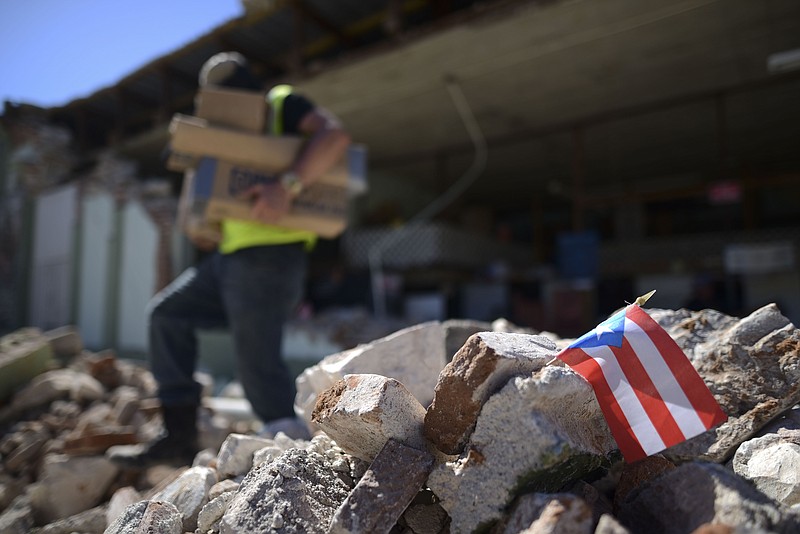GUANICA, Puerto Rico (AP) - Cars, cots and plastic chairs became temporary beds for hundreds of families who lost their homes in southwest Puerto Rico as a flurry of earthquakes struck the island, one of them the strongest in a century.
The magnitude 6.4 quake that struck before dawn Tuesday killed one person, injured nine others and knocked out power across the U.S. territory. More than 250,000 Puerto Ricans remained without water Wednesday and another half a million without power, which also affected telecommunications.
Another strong aftershock of a 4.7-magnitude struck Wednesday near the island's southern coast at the same shallow depth as Tuesday's earthquake. No serious damage was immediately reported.
More than 2,000 people were staying in government shelters in the island's southwest region as U.S. President Donald Trump declared an emergency and Puerto Rico Gov. Wanda Vzquez activated the National Guard.
"The magnitude of this event is so serious that the state government and the municipal governments of Puerto Rico do not have the capacity to respond effectively," she said as she praised Trump's decision.
The hardest hit municipality was the southwest coastal town of Gunica. More than 200 people had taken shelter in a gymnasium after a quake Monday, only for the latest shake to damage that structure - forcing them to sleep outside.
Among them was 80-year-old Lupita Martnez, who sat in the dusty parking lot with her 96-year-old husband by her side. He was sleeping in a makeshift bed, a dark blue coat covering him.
"There's no power. There's no water. There is nothing. This is horrible," Martnez said.
The couple was alone, lamenting their caretaker had disappeared and was not answering their calls. Like many Puerto Ricans affected by the quake, they had children in the U.S. mainland who urged them to move there, at least until the earth stops shaking.
While officials said it was too early to estimate the total damage caused by the string of quakes that began the night of Dec. 28, they said hundreds of homes and businesses in the southwest region were damaged or destroyed. Just in Gunica, a town of roughly 15,000 people, nearly 150 homes were affected by the quake, along with three schools, including one three-story structure whose first two floors were completely flattened.
In Gunica itself, "We are confronting a crisis worse than Hurricane Maria," said Mayor Santos Seda, referring to the 2017 storm that devastated the island. "I am asking for empathy from the federal government."
He said officials believe the homes of 700 families in his municipality are close to collapsing.
Tuesday's quake was the strongest to hit Puerto Rico since October 1918, when a magnitude 7.3 quake struck near the island's northwest coast, unleashing a tsunami and killing 116 people.
More than 950 quakes and aftershocks have been recorded in the area of Tuesday night's event since Dec. 31, though most were too weak to be felt, according to U.S. Geologic Survey.
The USGS said while it's virtually certain there will be many aftershocks in the next week, the chance of a magnitude 6 quake - similar to Tuesday's - or stronger is around 22 percent.
In Gunica, some people dragged mattresses outside their homes or set up small tents.
Authorities were trying to figure out where to shelter them all as they handed out blankets, food and water to families gathered at the gymnasium for a second night in a row. Many had their belongings in large garbage bags as they sat haphazardly on unstable plastic chairs. Some slept. Others cradled their dogs and many simply stared listlessly into the distance. One elderly man spent an entire day in his wheelchair, refusing to lay down on a cot.
Meanwhile, a handful of people slept in their cars, in chairs or on the ground as cots ran out.
Psychologists met with dozens of people affected by the earthquakes, going door-to-door Monday in affected neighborhoods and then visiting people in shelters Tuesday. Among them was Dayleen Ortiz, who set up a speaker on the roof of her car to blast uplifting salsa music and provided crayons and paper to children and urged adults to shake their fears.
"There is a lot of uncertainty," she said. "We don't know if this is going to continue."
Reconstruction has been slow, and the earthquake was the newest blow to an island where thousands of people have been living under a blue tarps since the hurricane and the power grid remains fragile.
"I can't stand this," 64-year-old Zenaida Rodrguez said as she sat under a tree and the ground again rumbled. "Did you feel that?"

